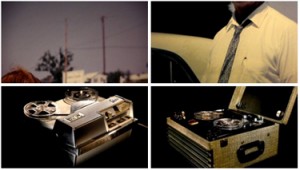Film Interview: Director Jane Gillooly on Sex, Lies, and Audiotape
This unique and carefully constructed impressionistic narrative encourages viewers to free-associate, assess, and imagine the romantic relationship through the filter of their own memories and experiences.
Suitcase of Love and Shame. Directed by Jane Gillooly. Pre-show introduction by Gillooly; Q+A with director following the screening. At the Institute of Contemporary Art, Boston, MA, March 30, 7 p.m.
By Tim Jackson
Following its sell-out screening at the Ann Arbor Film Festival, Suitcase of Love and Shame is receiving its area premiere this Saturday. Jane Gillooly’s new film is built from audiotapes found in a 50-year-old suitcase that was auctioned in 2009 on eBay for $100. The tapes are a remarkable aural document of a passionate and adulterous affair between a married, Midwestern veterinarian, Tom, and his lover, Jeannie. Why the tapes and documents were so carefully preserved is a mystery, but Gillooly has transformed them into a riveting, universal exploration of desperate love and illicit passion. Taking on the challenge of constructing a film without actors, Gillooly makes exhilarating use of a montage of images and sounds: this unique and carefully constructed impressionistic narrative encourages viewers to free-associate, assess, and imagine the romantic relationship through the filter of their own memories and experiences. What’s more, the evocative and compelling story also yields some real surprises.
I talked to Gillooly about the film’s use of imagery, the light it sheds on the sexual revolution of the ’60s, and its relationship to her earlier movie, Leona’s Sister Gerri.
Arts Fuse: How difficult was it working with old materials?
Jane Gillooly: Audiotape that was made in the mid-’70s through the ’80s was crap, so had they recorded these tapes then it would have been much harder to get good sound. Audiotape made in the early ’60s was much better. So the tapes were in remarkably good shape. I also had some expert sound people working on it. I worked on it, some other people worked on it, and then the audiotape went through a professional mix.
Arts Fuse: How challenging was the construction of the accompanying images?
Gillooly: It was a bit of a back-and-forth regarding where I was going to put images and where I wasn’t. I didn’t want to illustrate the audio too directly. Sometimes I’d shoot a scene not knowing exactly where it might go but knowing that this was a “Tom scene” or a “Jeannie scene.” Her scenes had more to do with longing and looking out a window, or maybe we’re outside, eavesdropping on her recording these tapes. I might look for something in the natural world that would work. Granted, some of the metaphorical images may seem sort of obvious, but you’re so focused on listening to the details and richness and texture of the audiotapes that you’re not thinking about the images all that carefully. The Jeannie stuff is very sparkly, and Tom is very subdued, melancholy.
Arts Fuse: Throughout the film, there is a seamless blend of suitcase materials with staged, constructed, and natural images.
Gillooly: I actually did find their houses, though those you see in the film are not the actual ones. What I needed was to find a neighborhood that felt like it could be associated with this house or that house. During the very first shot [in the house sequence], there is a detail of some bricks and a small set of stairs. That is actually a detail from one of their houses. The initial sequence gradually gives us detail of homes on the street and at the last minute goes to HD footage as the camera moves down the road of of a Midwestern town. There are images from the hotel rooms where they took the pictures, the beds and stuff, but only a few are in the film. There were graphic shots available, but I decided to not use them.
Arts Fuse: There are themes in the film about conscience, consequences, social mores, private morality, and even male privilege during this period of American life, which was just prior to the flowering of the sexual revolution.
Gillooly: Tom and Jeannie certainly aren’t the first people to be doing this, but I don’t think they really thought anybody else was doing it. I think that they thought that they were somehow unique in what they were doing. As long as we’ve been in the age of mechanical reproduction there have been people taking pictures and chronicling their sexual exploits. So that’s not surprising. But what does surprise me is they did it in such amazing detail. They were creating a memory library. I don’t know if many people pick up on this, but way that the material is shaped, Jeannie was really the person who took more responsibility about making sure the documentation took place. She created the spaces for these things to happen.
Suitcase of Love and Shame trailer from jane gillooly on Vimeo.
Arts Fuse: Are there any comparisons to be made between this movie and your earlier film Leona’s Sister Gerri, which was released in 1995. In the former film, you pieced together the tragic story behind a horrid image from the police records of an illegal abortion.
Gillooly: Leona’s Sister Gerri takes place at the exact same moment in time as Suitcase of Love and Shame. The woman who died of the illegal abortion died in 1964 and that was during the height of Tom and Jeannie’s affair. When I used to talk about Gerri with audiences, I would frequently hear myself saying, “It’s easy to think she died from an illegal abortion. She died of shame because she couldn’t talk to anybody about it. She couldn’t go to anybody for help because she was so shamed by it.” It’s interesting that Tom and Jeannie are in exactly the same situation. Jeannie didn’t happen to become pregnant, but she could have been Gerri Santoro. Birth control was illegal back then. Somehow we associate the sexual revolution with young college students. Tom and Jeanie preceded the sexual revolution, but they were extremely involved in it in their own way. Still, they were a generation older than the college students: they didn’t really have the opportunity to think more freely.
Tim Jackson was an assistant professor of Digital Film and Video for 20 years. His music career in Boston began in the 1970s and includes some 20 groups, recordings, national and international tours, and contributions to film soundtracks. He studied theater and English as an undergraduate, and has also has worked helter skelter as an actor and member of SAG and AFTRA since the 1980s. He has directed three feature documentaries: Chaos and Order: Making American Theater about the American Repertory Theater; Radical Jesters, which profiles the practices of 11 interventionist artists and agit-prop performance groups; When Things Go Wrong: The Robin Lane Story, and the short film The American Gurner. He is a member of the Boston Society of Film Critics. You can read more of his work on his blog.


